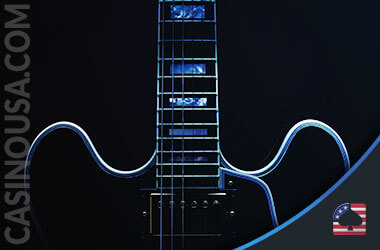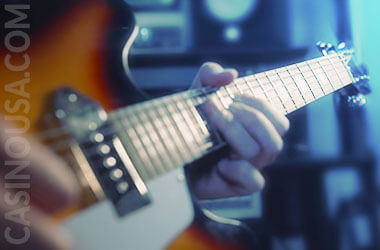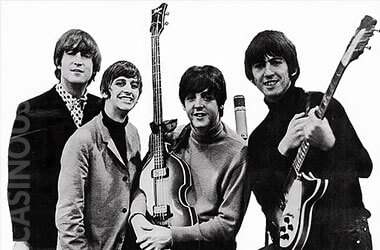
Guitar players nowadays often argue whether the Fender Stratocaster or the Gibson Les Paul is the best electric guitar ever, forgetting about another instrument that generated lots of buzz back in the day.
It was created by Epiphone (owned by Gibson) and was simply named Epiphone Casino. Ever since the first Casino was launched, it became the face of rock’n’roll and the best-selling guitar to bear Epiphone’s logo.
Vintage Epiphone Casino History
After Gibson purchased Epiphone in 1957, company officials decided to launch a new line of guitars branded as Epiphone. Before its acquisition by Gibson, Epiphone mainly made upright basses, not guitars. On the other hand, Gibson had several unsuccessful attempts to make bass guitars, but none of them went well. Guitars were Gibson’s specialty, and when you look at the modern Gibson collections, you won’t find any legendary basses.
After the Epiphone Sheraton was released in 1959, Gibson decided to make another Epi model, making some changes from the standard Epi models. These included different pickups and features that distinguished Gibson from Epiphone.
The Casino was initially called Epiphone model E230TD, which wasn’t the most appealing name. The name Casino had a ring to it, which turned out to be a pretty good marketing move. Then again, guitarists know how to separate the wheat from the chaff, so the remarkable quality of Epi Casino was what turned it from popular to iconic.
The first models were made in 1961 in Kalamazoo, Michigan, setting all specs in place. The official Epi catalog described Casino Epiphone’s double cutaway styling as ultra-thin and ultra-modern. The original price for single-pickup models (which also included vibrato) ranged from $230 to $269.5. Those interested in buying the model with two pickups had to pay between $275 and $314.5. This version also included a vibrato.
The price of original Epiphone Casino guitars made in the 60s varies nowadays, but you will rarely find one below $7,000. We’ve researched some models, and their prices went up to $12,000. According to various guitar forums, some Casino models cost around $25,000.
Modern Casino Epiphone
Vintage Epiphone Casino models are still produced today, with minor changes and upgrades, mainly in pickup design. They come in several color finishes — natural, vintage sunburst, and turquoise.

All Casino models still have an archtop body style with a 5-ply layered maple with basswood bracing top. The body is made from layered maple with a gloss finish. As for the neck, the fingerboard is crafted from Pau Ferro (Brazilian ironwood), which has 22 frets. The scale length is 628.65 mm, and the fingerboard radius is 304.8 mm. The nut width is 42.67 mm.
Both bridge and neck pickups use Dogear P-90T Classic™, and the guitar uses the three-way Epiphone toggle as a pickup selector.
Prices range depending on several things, the color of the guitar being an important factor. Vintage sunburst and natural Casino guitars cost around $700, whereas the turquoise model is about $650.
Please remember that this is just one of the several variations of the Casino Epiphone model. For example, the Casino Coupé version has a much smaller body and is made to resemble Gibson ES-339. We should also mention the famous John Lennon hollow body guitar, which was a Casino he adjusted for him and was later produced as such (1965 Epiphone Casino).
Apart from the US, Casino guitars have been manufactured in China, Korea, and Japan.
Epiphone Casino and The Beatles
What makes Casino Epiphone so unique? For starters, it was played by generations of inspirational musicians and guitarists. Some of the names worth mentioning are Howlin’ Wolf, George Harrison, John Lennon, Paul McCartney, Dave Davies, Paul Weller, The Edge, Keith Richards, Peter Green, Noel Gallagher, Gary Clark Jr, and many others.

Chances are you recognize at least three names in this list, all members of The Beatles. Yes, it’s true. Three out of four members (everyone except Ringo Starr) played the Casino at one point in their careers.
It all started in 1964 when Paul bought his first Casino and restrung it to make it suitable for left-handed players (as he was a leftie). His decision was heavily influenced by John Mayall, one of the leading blues guitarists back in the day. John and George soon discovered Casino’s potential, instantly buying one each. The entire Revolver, arguably one of the best albums recorded by The Beatles, included Epiphone Casino guitars.
Some notable songs in which McCartney played his Epi Casino were Ticket to Ride, Drive My Car, Taxman, and Helter Skelter.
Lennon’s Casino was the source of inspiration for manufacturers who mimicked the stripped look of his Epi instrument. Namely, he took down many elements of his Casino but retained the original nickel tuners. This guitar was used for the legendary Apple rooftop concert on January 30, 1969, which remains the most recognizable concert by The Beatles.
Final Thoughts: Epiphone Casino as the Leading Guitar of an Era in Music
Even though the Casino was overshadowed by guitars such as the Stratocaster and the Les Paul in the years to come, it reappeared later, with a line in Japan deciding to start manufacturing Casinos in the 80s. Many of those newer Casinos were inspired by the Beatles.
Nowadays, Casinos are mass-produced, but the ones from the 60s have true value and are admired by guitar collectors around the globe.
Still, some of the recognizable chime and sparkle of the original Casino sound is retained in most new versions. The neither-harsh nor-brittle twang that could grow into a nice growl with enough gain and volume is something that The Beatles’ Revolver was recognized for. Of course, depending on the pickup, the tone can be adapted from jangly (bridge) to warm (neck).

